There is an opinion that moles on the head in the hair are dangerous, although there are also moles whose existence their owner is not even aware of.
Moles or nevi can appear on different parts of the human body. These are neoplasms that stand out on the skin with their color and structure.
It is not uncommon for moles to appear on the head. Such moles can cause a feeling of discomfort and are easily damaged as a result of external influences.
Causes of moles on the head
The factor that causes the appearance of nevi on the head is the increased content of melanin in the upper part of the skin.
This feature can arise as a result of several reasons:
- weakened immune system;
- genetic predisposition;
- strong susceptibility to ultraviolet radiation and sun exposure;
- birth defect;
- skin diseases;
- hormonal imbalance of the body (occurs during the period of teenage changes in the body or pregnancy);
- skin damage.
Such factors that cause the appearance of nevi can occur throughout a person’s life., even in old age, so you should be careful about the occurrence of neoplasms.

To find out which moles on the head in the hair are dangerous, you should visit a dermatologist.
Types of moles that appear on the head in the hair
Nevi can be divided into several different groups depending on different characteristics.
Based on their origin, such neoplasms can be divided into 2 types:
- congenital – arise as a result of disruption of melanocyte division even at the stage of fetal development in utero;
- acquired - appear as a result of external exposure to the skin of an excessive amount of ultraviolet rays.
If we talk about the structure of moles, the following subgroups can be distinguished:
- vascular – arise as a result of the growth and close proximity of several vessels, usually have a reddish or bluish tint;
- non-vascular – appear due to a significant number of melanocytes, have a dark color;
- flat – the most common nevi, they are not damaged as a result of external influences and, as a rule, do not cause any discomfort to the owner;
- convex – rise slightly above the surface of the skin and look like a hemisphere; having similar moles on the head in the hair is dangerous, since they are very easy to injure, so experts usually advise removing them;
- hanging – rarely appear in the head area, they represent a head connected to the skin with a kind of leg; due to the high likelihood of damage, the best option is to remove them.
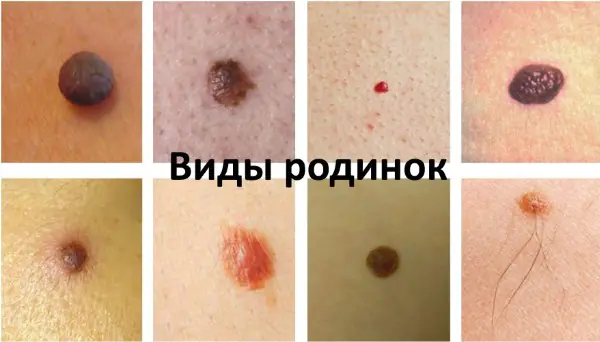
Based on their size, nevi are divided into:
- small – with a diameter of no more than 1.5 cm;
- average – 1.5-10 cm;
- large – with a diameter of more than 10 cm;
- gigantic – occupy more than half of the scalp.
Which moles on the head are safe?
In most cases, moles on the head are benign neoplasms that do not pose any danger to the owner.
The safest in this regard are flat non-vascular nevi, with a diameter not exceeding 0.5 cm. Such moles do not require any special care or special attention.
Any moles on the head in the hair can be dangerous if they begin to cause discomfort to their owner.
Moles in the hair on the head that require specialist consultation
Nevi on the head are not just an external defect, but a phenomenon that requires careful attention and careful handling.
A direct indication for seeking medical advice from a specialist is the presence of large convex, and especially hanging, moles in the hair. Such formations can very easily be injured when combing or washing your hair.
The main problem with such moles is that they can easily degenerate into malignant neoplasms or melanomas., successful treatment of which is possible mainly in the initial stages.

Such neoplasms develop quickly and metastasize to other organs, which can lead to death within a few months.
It is important to know! Often the cause of nevus degeneration is various injuries that provoke negative processes.
That is why moles that rise above the surface of the skin and are large in size require contacting a specialist and making a decision about their removal.
Dangerous resort to traditional methods of removing moles on the head in the hair, this can cause damage and degeneration.
Also, you should not cover such formations with a band-aid, since the greenhouse effect can also provoke unwanted processes.
How to properly care for a mole on your head
Moles in the hair require careful handling.
There are several simple rules that, if followed, can minimize the risk of damage to tumors on the head:
- You should not use cosmetics containing solid substances that can cause mechanical damage to the skin (scrubs, peelings), as well as shampoos and masks that contain strong chemicals;
- Avoid blow-drying this area of the skin;
- Do not scratch or scratch your head with sharp objects, use hairpins and hairpins carefully;
- If the mole is still damaged, it is necessary to treat it with hydrogen peroxide, stop the bleeding, in case of severe damage, seek medical help;
- Carefully monitor the condition of the mole and consult a doctor if any changes occur.
Be careful! Microtrauma to a mole in itself is not dangerous; it is important to prevent infection and inflammation.
Signs of degeneration of a mole
There are 5 main signs of degeneration of a mole, the appearance of which requires urgent medical intervention:
- The emergence of asymmetry – in a normal state, if you mentally divide a mole in half, both parts should be the same;
- Color change – darkening or redness of the nevus is an alarming symptom. Normally, the color of a mole should be uniform and unchanged;
- Jagged edges – benign neoplasms have clear, even boundaries;
- Resizing – if a mole increases in size or becomes convex from flat, then you should immediately contact a specialist;
- The appearance of unpleasant sensations – pain, itching, peeling, bleeding. Under normal circumstances, a nevus should not cause discomfort.
Important to remember! Even the appearance of one of the above signs is a reason to seek medical advice.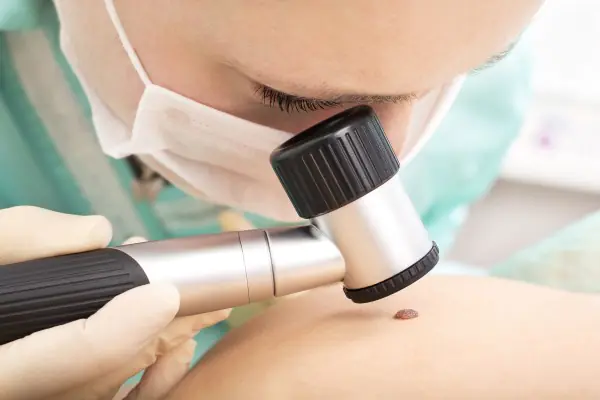
Is it necessary to remove moles on the head in the hair, when is it dangerous?
Very often the question arises: to remove moles or not. The decision should be made only after consultation with a specialist.
There are several indications for removing nevi:
- the emergence of processes of degeneration of a mole into a malignant neoplasm;
- convex or hanging shape of the mole, as it is easy to injure in everyday life;
- finding a mole in a place where it is constantly exposed to mechanical influence;
- a cosmetic defect that causes discomfort to the owner of the mole;
- the appearance of large moles in a child, since children cannot take the necessary precautions.

| Methods for removing moles on the head in hair | Peculiarities |
| Surgical | Allows you to send tissue for histological examination and find out whether these formations are dangerous or not. |
| Laser | The most gentle method, leaves no traces. |
| Using liquid nitrogen | It is carried out in several passes and leaves no traces. |
| Electrocoagulation |
Produced using high-frequency current, it can cause discomfort after the procedure. Radio wave A gentle, non-contact method using exposure to radio waves.

Any new growths on the head require careful and careful treatment.
It is important to follow simple rules to reduce the risk of injury to moles and the development of undesirable consequences. Any change in the nevus or the occurrence of unpleasant sensations is a reason for an immediate visit to the doctor.
This video will tell you about moles on the head, in the hair, on the body, and how dangerous they can be:
In this video you will see and hear which moles can be hazardous to health:
According to popular belief, moles are special marks that carry information about the fate, character, hidden potential and natural abilities of a certain person. And if there are many such signs, then the person marked by them should be incredibly happy in life.
Causes of moles
The appearance of moles on the body is explained by several reasons: heredity, weak immunity and the result of direct exposure to sunlight, to which the head is most exposed. If nevi (the medical name for moles) are well known to their owner, do not bother them, do not grow or change color and shape, there is no need to worry too much.
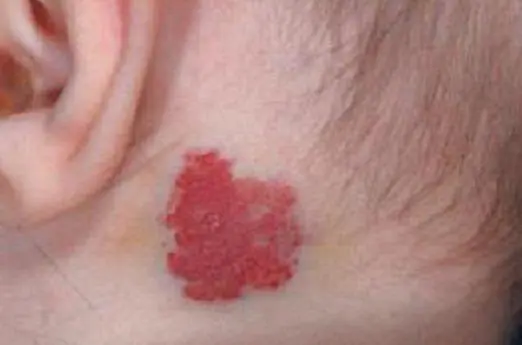
According to their structure, moles are divided into:
- Vascular. (Looks like a red mole on the head, formed with the participation of blood vessels that form nodules as they grow).
- Non-vascular. (They are the result of an accumulation of melanocytes (pigment cells), the number of which determines the color of the nevus; the more there are, the darker the mole).
Shapes of moles
A mole on the head in the hair also varies in shape and can be flat or convex. The flat formation is located in the upper layer of the skin and looks like a spot. Usually it does not require special attention, since it does not cause concern to a person. A convex nevus rises above the surface of the epidermis, sometimes has some resemblance to warts and is always at risk of injury. If for some reason a mole on the head is damaged, you should immediately stop the bleeding using a tampon soaked in hydrogen peroxide. Apply dry gauze folded several times to the affected area, press it to the wound and hold it there for 5-10 minutes. Then be sure to contact a medical facility for help. The partially torn mole will be professionally removed by specialists and immediately sent for analysis. If the nevus is completely torn off, it must be wrapped in gauze soaked in saline solution and also submitted for histological examination, which allows one to determine the type of neoplasm and make the correct diagnosis. Such analysis is an indispensable basis for recognizing cancer diseases.
How to care for a mole on your head
Moles on the head (photo) are not only a cosmetic defect; This is a fairly serious problem that requires close attention and careful handling.

Caring for a mole of this type should be very careful and careful. You should not use peelings and scrubs in the place of its formation, in particular on the head. The mole may be located under the hair, so you need to comb it carefully, try to knead the area and not touch the skin in this area with the comb. You need to make sure that the nevus is not put under pressure by a headgear or glasses. It is imperative to monitor the size, shape and color of the mole on the head and consult a doctor in case of any pathologies.
No self-medication!
A large convex mole on the head or under the hair most often needs to be removed, especially if it creates a clear aesthetic defect. It is highly not recommended to take independent measures to remove a mole (tying with red thread, using celandine, etc.). Even if good friends gave valuable advice, and they helped someone, you should not touch the mole! You should not cover large nevi with a band-aid, as this will create a greenhouse effect - comfortable conditions for the degeneration of a harmless mole into a dangerous melanoma. The very first step in caring for or removing a tumor should be to contact a dermatologist.
Signs of degeneration of a mole on the head
Any mole on the head under the hair, when exposed to certain internal and external factors, is at risk of becoming a malignant formation. Therefore, sometimes its removal, especially in the scalp, is the best option to avoid a much greater danger. There are 5 signs by which you can determine the degeneration of a mole and start sounding the alarm:
- Asymmetry. Using an imaginary axis, you need to divide the mole into two parts; a bad nevus will have halves of different sizes. In clinics, for accurate diagnosis, they use a special drug that evaluates the mole using a 12-axis method.
- Color. A mole located on the head has changed color: it has turned black or red, and the skin around it has become white.
- The edges. Changes and irregularities are observed along the contour.
- Dimensions. Large moles (more than 6 mm) are most likely to degenerate. Although there have been cases of transformation into melanoma of a 1-mm nevus.
- Dynamics. The manifestation of various external changes - peeling, crusts, cracks, bleeding, up to the sudden disappearance of the mole.
When to see a dermatologist
If you detect at least one of the 5 signs, as well as pain in the mole or its damage, you should immediately consult a doctor. The specialist will tell you the sequence of further actions: either removal of the tumor, or further monitoring of it and careful care.
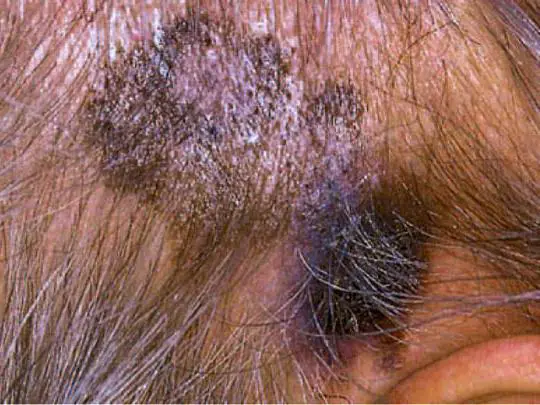
The transformation of a mole into melanoma can be confirmed by clinical diagnosis at the first stage and epiluminescent computer dermatoscopy at the second. Under no circumstances should you do a biopsy of the tumor - an examination that involves removing a piece of material. The diagnosis of melanoma can be refuted or confirmed only after a histological analysis.
Hair on a mole: how to get rid of it
You cannot remove hair from moles; it is recommended to simply cut them off. By the way, vegetation on a nevus is a good sign, indicating a high degree of cell maturity and a minimum chance of degeneration into melanoma.
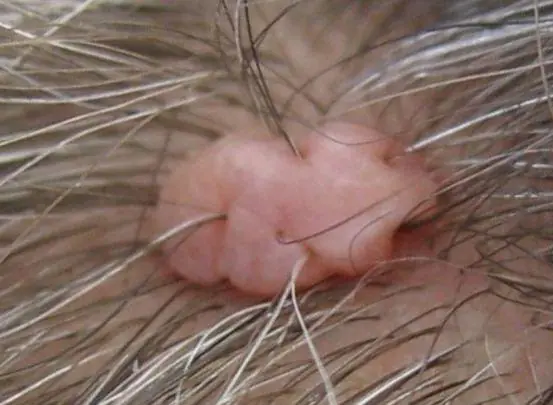
Why do you need to get rid of a mole?
Nevi located on the head, especially in the scalp, most often need to be removed. Reasons confirming the correctness of this decision:
- high probability of damage;
- regular exposure to cosmetics (shampoo, soap, skin care products);
- incomplete protection from ultraviolet rays (moles on the head receive them many times more than on other parts of the body);
- aesthetic unattractiveness.
Should I delete or not?
You should definitely listen to your own intuition and feelings. Maybe a mole located on the head does not interfere at all, and the person is accustomed to its presence. Then extreme caution should be exercised in relation to such a problem area. In any case, you will need competent consultation with a specialist who is able to assess the potential danger of pigment formation and suggest what measures are best to take: regularly monitor or remove.
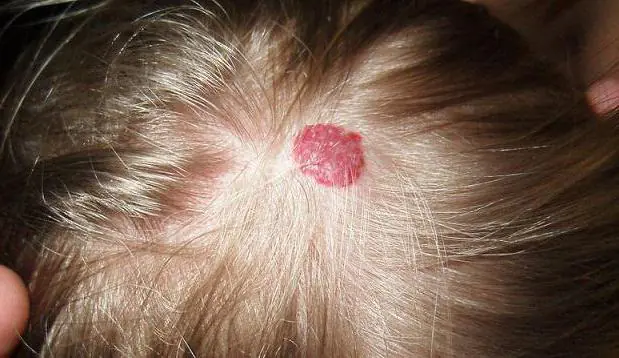
Ways to remove moles
Surgical method. The mole is cut out along with adjacent tissues. The disadvantage of this method is the scar at the excision site. Advantage: the ability to take material for histological analysis.
Laser. It is low-traumatic, safe, painless, which is why it is most in demand. The laser beam, which has a bactericidal effect, stops bleeding without causing complications. In addition, after the procedure there will be no scars left on the skin: only nevus cells will be removed, without affecting the surrounding tissues.
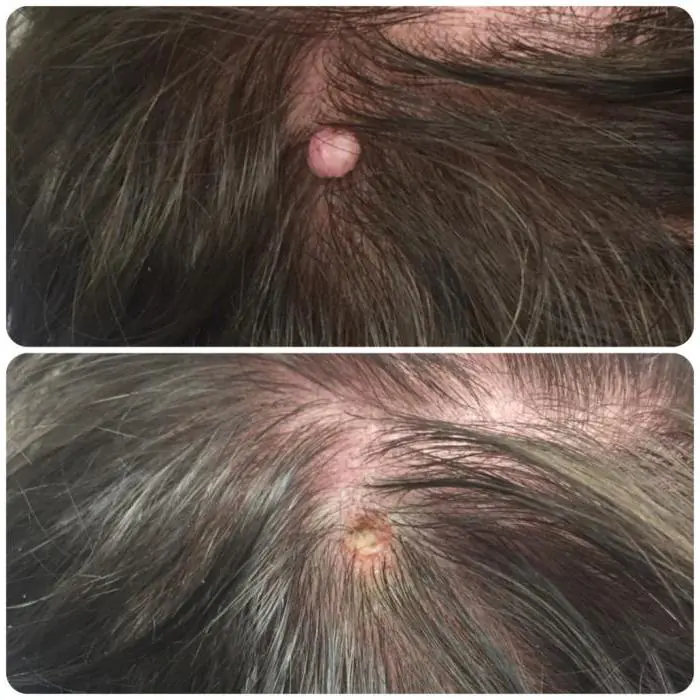
Cryodestruction. The destruction of nevus tissue is carried out by ultra-low temperature liquid nitrogen (down to -196 o C), which is enough to instantly freeze and destroy any organic formation. The procedure takes from 10 seconds to 3 minutes and does not cause any pain.
Electrocoagulation. A method in which the mole is exposed to high-frequency current discharges, playing the role of a kind of scalpel. With the help of delivered discharges, micro-incisions are made step by step, cutting off the mole in small layers. The strong thermal effect generated by the electric field prevents bleeding, thereby minimizing the risk of infection.
Radio wave. A gentle, non-contact technique based on careful tissue cutting and the literal evaporation of pigmented cells using radio waves. The advantage of this method is the absence of physical pressure on the upper skin layers, painlessness, absence of scars and cicatrices, and the possibility of histological analysis.
If the mole is benign, then it is better to choose the least painful method, after which the affected area will quickly heal and will not remind you of the operation with scars or scars. If a tumor is suspected of being malignant, it is better to use a method that allows for histological analysis of tissue.
What does a mole on the head mean?
Each mole carries certain information about a person. Located in the hair, it is a favorable sign and is found in people who are capable of thinking. It most often marks great minds and outstanding researchers. A hidden and invisible mole will indicate a secretive person.
Pigment formation on the crown of the head, a special energy point, is characteristic of people with extraordinary thinking abilities. These individuals can easily achieve success in professional and intellectual fields and are able to lead a detached lifestyle. Often such people have the gift of clairvoyance, but not everyone knows how to properly develop this potential.
A mole on the back of the head is inaccessible to the eye of its owner, whose characteristic signs are isolation and aloofness. Such a person will never flaunt his personal life and will not discuss his own problems with others. It is quite difficult to have a conversation with him.
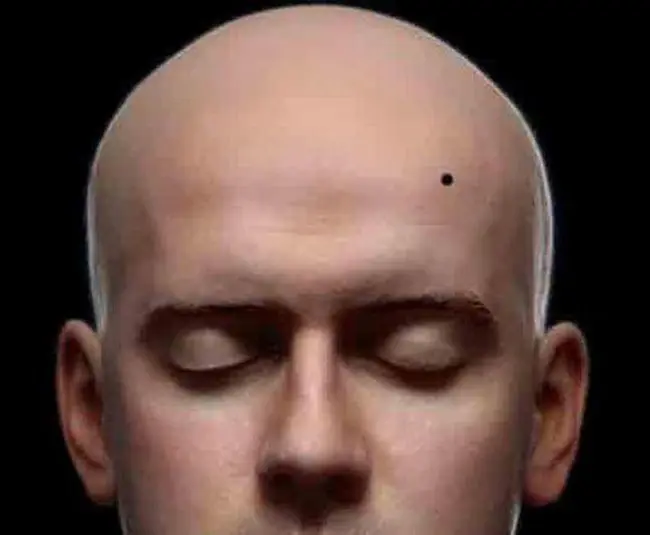
The temples are considered a very vulnerable area, so a mole in this place will indicate a person’s high sensitivity and vulnerability. True, it is not always possible to guess this: the closer the nevus is located to the hair, the more carefully the person hides her vulnerable nature. A mole located on the right temple will reveal a special person, with developed intuition, who can subtly grasp the mood of his interlocutor and delve into the true reasons for his actions. This allows him to quickly assess any situation and make smart decisions.
A mole on the top of the head portends success and wealth, and the darker it is, the more significant these benefits will be.
A mole on the forehead is a symbol of success
A mole in the upper part of the forehead indicates a courageous and strong-willed person, capable of achieving success in any field. Those around him easily obey his charisma. Such individuals make good politicians. The lower the mole is located in the forehead area, the less strong a person’s character, even weak-willed.
Wherever a mole is located on the head, it can have both positive and not very pleasant meaning for its owner. In any case, such pigment formation requires special care and supervision from a specialist. Otherwise it can become a source of big problems.
Moles (nevi) and birthmarks are benign neoplasms that can appear on any part of the body and in any quantity. In most cases, they are not dangerous to human health and life. A mole on the head can be dangerous when it is often injured or changes its color, shape, or size. In this case, you need to consult a doctor, undergo an examination and, possibly, remove the formation.
What does it look like
The appearance of the formation in the photo may vary. All of the following options are normal:
- The color is most often brown, but can be black, red and even purple. A white rim may appear around.
- They rise (convex) or do not rise (flat) above the skin level.
- The mole can be located on any part of the head: the scalp (back of the head, crown), face.
- The size ranges from a pinpoint to 5 cm or even more. Birthmarks are often larger in size.
- There are no additional symptoms. The patient should not be bothered by pain, numbness, or burning. The appearance of these symptoms most likely means that we are talking about another pathology.
Red mole on the head: is it dangerous?
In most cases, moles on the head are not dangerous and do not require diagnosis or treatment. However, there is caution associated with the likelihood of malignancy (malignancy) of such formations. Under the influence of various factors (damage, ultraviolet radiation), a mole can degenerate into melanoma. That is why every person should be able to distinguish a dangerous mole using special criteria.
Hazard criteria
Moles on the scalp require special attention, as they are often injured when combing or other manipulations. There are 5 criteria that help assess the danger of a nevus: asymmetry, edge, color, size, dynamics (abbreviated as ACORD).
If you draw a conditional line along the center of the formation, both halves should be identical, even, and symmetrical. Asymmetric halves of a nevus are one of the signs of danger.
Normally, the edge of the nevus is smooth and clear. Blurry edges, as well as jagged edges and deformation are a sign of danger.
The formation can have different colors: brown, black, red (all of these options are the norm). It is not the color itself that is important, but its uniformity. The presence of any inclusions, darkening, or blanching should alert the patient.
The larger the nevus, the higher the risk of malignancy. The diameter of a formation greater than 6 mm is an alarming sign.
It is very important to monitor the nevus over time. You should be wary of the appearance of roughness, ulceration, as well as the rapid growth of formation.
If the formation is localized on the head, it is not always possible to conduct a self-examination. It is better to ask someone close to you to examine hard-to-reach places (the back of the head, the crown of the head).
What should a patient do if the criteria exist?
If you identify at least one of the above criteria, you should definitely contact a dermatologist. This does not always indicate malignancy of the nevus, but it is better to be safe.
Who is at risk
There is a group of people who are especially at risk of nevus degeneration into melanoma. The risk group includes:
- men over 50 years old;
- persons with a family history (melanoma in relatives);
- persons with more than 100 moles;
- persons susceptible to sunburn;
- persons with fair skin, red hair, freckles.
Anyone who is at risk for melanoma should be regularly monitored by a dermatologist. The frequency of preventive examinations is once a year (even without dangerous signs).
How does an appointment with a doctor go?
The doctor will carefully examine the nevus, determine the presence of signs of malignancy, and collect an anamnesis of life and disease. An additional examination is prescribed, usually the consultation is limited to dermatoscopy. Dermatoscopy is a method of visual assessment of skin tumors. For the study, a dermatoscope is used, with which you can obtain an image magnified 10 times.
Dermatoscopy is a preliminary diagnostic method. It will not be possible to make a final diagnosis (benign or malignant formation, what type), this requires a histological examination.
Mole on the head in the hair: what causes the appearance
A mole is a collection of melanocytes that are located between the lower (dermis) and upper layers of the skin (epidermis). Melanocytes are skin cells that produce the pigment melanin. It is this pigment that causes the color of moles to change. Red formations represent proliferation of blood vessels.
Almost every person has birthmarks. They can be formed under the influence of various factors - genetic, hormonal, and the external environment.
One of the most common causes of the formation of nevi (both congenital and acquired) is genetic abnormalities. Hereditary predisposition is influenced by environmental factors.
Nevi grow under the influence of various hormones. For example, the number of moles increases during puberty and in women during pregnancy.
Sunlight triggers the production of melanin, which leads to the formation of moles.
Trauma, viruses, and radiation can trigger the movement of melanocytes to the epidermis.
Treatment
Not all nevi can be removed. In most cases, it is enough to follow simple recommendations to prevent complications. If a mole is often injured or there are signs of malignant degeneration, such a formation must be removed.
What to do at home
All activities carried out at home are aimed at preventing complications. No home treatment can effectively remove the formation.
Care Tips:
- try to wash and comb your hair carefully so as not to damage the nevus;
- do not use scrubs and peels on the scalp;
- if the mole is localized on the open part of the head, cover it with a sun bandage.
Under no circumstances should you remove the formation yourself! Such an attempt at treatment can damage the nevus and provoke the development of complications (malignization, bleeding).
One of the most important things you can do at home is preventative checkups. It is necessary to regularly examine the nevus and evaluate it using the ACORD algorithm.
Surgery
The final decision on the need to remove the nevus should be made by the patient together with the doctor after a complete examination. Surgical treatment is indicated for all patients with suspected melanoma. To remove the formation, different methods can be used - laser therapy, electrocoagulation, cryodestruction, surgical excision.
Description, advantages and disadvantages
Suitable for removing nevi, which are often injured (especially on open areas of the head). This is a modern treatment method that uses a laser to remove the formation. The procedure is performed under local anesthesia; no scars are left at the removal site. The main disadvantages include the high cost of treatment and the impossibility of removing malignant tumors.
The method is based on exposure to electric current. The nevus is cauterized, and after some time the necrotic tissue is rejected on its own. The procedure is performed under local anesthesia.
Exposure to liquid nitrogen is often used to remove small lesions. Freezing and subsequent destruction of the mole occurs. The procedure is painless, does not require anesthesia or local anesthesia, but is not suitable for removing large nevi. Sometimes several sessions are required for complete removal.
Surgical excision is the main treatment method for melanoma and large benign tumors. A scalpel is used for removal; the operation is performed under local or general anesthesia. After excision of the nevus or melanoma, the wound is sutured, and the formation is sent for histological examination.
Video
We offer you to watch a video on the topic of the article.





